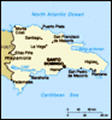Advertisement
Published: March 30th 2014
I can't mark quite where Batey Isabela is on this map, because it's hard to locate on the somewhat contradictory online maps. It's about where I've placed the route marker. Bateys are sugar cane plantations, and as a quick look at the DR/Haiti border reveals, many of the people in this region were brought over/came over to harvest. New legislation in the DR has disenfranchised multiple generations of people of Haitian descent, effectively rendering them stateless:
Now, intensifying a long and furious debate over their place in this society, the nation’s top court has declared that the children of undocumented Haitian migrants — even those born on Dominican soil decades ago — are no longer entitled to citizenship, throwing into doubt the status of tens of thousands of people here who have never known any other national identity. Randal C. Archibold,
The New York Times)
Trip assistant A. is reading Friere's
Pedagogy of the Oppressed. This seems as good a time and place as any to do so.
We were met at the Santo Domingo airport by Peace Corps volunteer Susan and former PCV Zach, who is now Courts for Kids's country representative. Just as the student group had to raise
their expenses and $5000 for the court, the person on the other end (typically a PCV) must also raise $5000. There's an additional community application and buy-in component, but I don't know it well enough to risk describing it. After a night at the hostel and breakfast, we took a van/minibus west. At our request, the driver blasted
bachata (though I admit that I'm more of a
reggaeton/dem bow sort).
Much bougainvillea, cinder block, brightly colored exteriors, glass embedded in the tops of walls, horses grazing on frontages and in lots.
As usual, I'd been assured that there were no birds. As usual, this isn't true. Several interesting birds in the trees across from the hostel. About 1 hour west, we began to see sugar cane. At 1.5, cacti. People are shorter and have darker skin. We see women balancing buckets on their heads. In Tamayo, we stop to buy plastic garbage cans--our shower and flush reservoirs.
An orientation and pragmatic guidelines for behavior--don't pet animals; don't give people stuff (rather, donations can be made at the end). Some discussion of not creating a culture of dependency.
At the batey, we dump our bags and change into
work clothes. It's clear we won't all fit in the abandoned house, so 4 students volunteer to sleep in the PCV's house or at the Doña's. We are mat-to-mat on the concrete floor, with mosquito nets taped to the walls. There is a toilet and shower stall, though we must use buckets. There are indoor spigots to refill the cans, a pleasing luxury.
The doña who's cooking for us serves rice, a little chicken, cabbage slaw, and potato salad at her house. I eat sparingly, though there must be at least 3 cups of rice on the plate. I can manage about 1/4 cup before I give myself blood sugar trouble.
I spend a few hours shoveling and raking gravel to level the surface of the court. Others shovel and pickaxe the loose soil/rocks around the court, which I'm not very good at. While waiting for the leveler to arrive, we take a walk around the community, including seeing the barracks where the workers used to be crammed in by the sugar companies. Now people are still crammed in, but they are rentals. Cane fields, a river (where our escort of little boys stripped and swam). Fences of
branches and barbed wire, some with clothes hanging to dry. Pigs, goats, sheep, chickens, dogs, and the occasional cat in the street. Big, flat sky, dusty, pebbly ground. Arizona meets Israel. Low humidity. Hot. This will work very well for my kind of endurance.
The leveler arrives and uses water in a tube to find the level, which is incredibly cool. While we were on our walk, more sand and gravel was dumped between the court and the colmado (convenience store and sometimes bar) under whose porch we'll be taking breaks.
At the house, los niños swarm, sticking their hands through the window louvers , screaming, pushing the door open. I wouldn't particularly care but they keep slamming the louvers (jalousies) and front door open and closed, and bouncing balls against the door and walls, which is somewhat overwhelming while trying to unpack and negotiate our first round of showers. It isn't darling, though since I can't do anything about it, I leave it be and reflect that right now anybody would probably seem intrusive. It's a little
World War Z with arms suddenly sticking in, hands outstretched, as los niños climb over each other to--what? Make contact
with us, I think. This ought to make me reflect on the social construct of privacy, but I'm too tired to be sufficiently philosophical.
The toilet tank leaks, but this is better than the bowl leaking. Still, it makes the bathroom pre-grubby. Better by far than going out in the night with no light and mosquitoes to use a latrine.
We debrief the first day with Susan, Zach, and Peter (another PCV who wants to build a court in his batey). A student is upset because a man asked why she was here if she didn't speak the language; we discuss feelings and possible responses. The power goes off (there are somewhat scheduled rolling blackouts), and we shower with flashlights/headlamps and sleep without fans until about midnight.
Advertisement
Tot: 0.247s; Tpl: 0.017s; cc: 11; qc: 45; dbt: 0.0572s; 1; m:domysql w:travelblog (10.17.0.13); sld: 1;
; mem: 1.1mb







